Scottish cities
Population trends for selected Scottish cities, 1991-2023

Glasgow consistently had the largest population of the selected Scottish cities from 1991 to 2023. Over the period 1991-2006, Glasgow’s population declined by 10% and then increased by 11% from 568,460 in 2006 to 631,970 in 2023. Dundee's population was steady from 1991 to 2023, while over the same period Edinburgh's population increased by 20% and Aberdeen's by 6%.
Population by deprivation decile in selected Scottish cities, 2022
30% of Glaswegians live in the most deprived 10% of areas in Scotland while only 5% live in the least deprived 10% of areas in Scotland. In contrast, 30% of people in Edinburgh live in the least deprived 10% of areas of Scotland and just 5% live in the most deprived areas.
Notes
It is worth noting that these city populations are based on local authority boundaries and thus do not reflect the size of the wider surrounding conurbation for each city. For example, the Greater Glasgow and Clyde population is 1.2 million, and using a wider definition of the Glasgow conurbation, encompassing the West of Scotland and including Lanarkshire and parts of Ayrshire, would bring the population to above 2 million.
The deprivation graph above shows the proportions of population of the four cities broken down by Scottish Index of Multiple Deprivation (2020) deciles. These deciles break down the population of Scotland into ten groups each containing approximately 10% of the population. Decile 1 represents the most deprived 10% of areas by population, decile 2 the next most deprived 10% of areas and so on, until decile 10 which represents the least deprived 10% of areas.
This page was last updated in March 2025.

